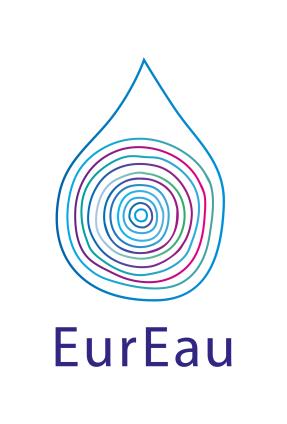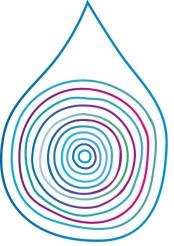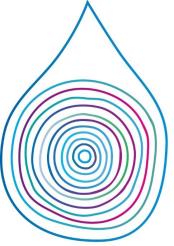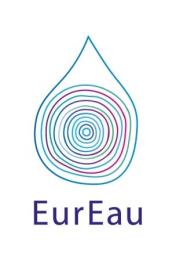Evel.ee

October 2015
EurEau's Contribution to the
European Commission's
Strategic Approach on
Veterinary Pharmaceuticals
in the Environment
Globally, pharmaceutical products are regularly administered to both livestock and domestic animals. This is essential for animal welfare and the economy, but doing so ultimately means that pharmaceuticals end up in the aquatic environment. Animals reared commercially are the highest consumers of these products and therefore veterinary medicines are largely a rural, rather than an urban, issue. EurEau believes that good agricultural and animal husbandry practices should be promoted and incentivised. Doing so will reduce the overall amount of pharmaceuticals in the environment and protect water resources, including those used for the abstraction of drinking water. As the main route for veterinary pharmaceuticals to the aquatic environment is diffuse, addressing their use at the source is the most effective solution.
1. Presence in the water cycle There are few studies concerning the presence of veterinary pharmaceutical in the water environment. Those that do exist, demonstrate the presence of a variety of medicines in surface and groundwater. A comparative study on the sales of veterinary antibacterial agents between 10 European countries revealed that veterinary antibiotics are used in each country surveyed, with tetracyclines1, b-lactam antibiotics2 and sulfonamides3 as major groups of active substances (Grave et al., 2010)4.
Among these, in groundwater, three sulfonamides were most frequently detected, namely sulfamethazine, sulfamethoxazole, and sulfadiazine.
1 e.g. chlorotetracycline, doxycycline, oxytetracycline, tetracycline, etc.
2 e.g. ampicillin, cefalotin, cefalexin, cefoxitin, etc.
3 e.g. sulfadiazine, sulfamethazine, sulfachloropyridazine, sulfadimethoxine, sulfaguanidine,
sulfamerazine, sulfamethoxypyridazine, sulfapyridine, sulfathiazole, etc.
4 Grave, K., Torren-Edo, J., Mackay, D., 2010. Comparison of the sales of veterinary antibacterial
agents between 10 European countries. J. Antimicrob. Chemother. 65, 2037–2040.

October 2015
EurEau's Contribution to the European Commission's Strategic Approach on Veterinary
Pharmaceuticals in the Environment
For example the market for veterinary drugs in Germany can be characterised by the following, based on sales figures:
28% anti-infectives, 18% parasiticides, 28% biopharmaceutics and
26% specialised pharmaceuticals. Sales of pharmaceuticals for animal production and for domestic animals are approximately balanced (BfT, 201)5 (Ref 2). Anti-infectives are primarily used for animal husbandry.
The total amount of veterinary antibiotics in Germany in 2012 was
1619 tonnes including 566 tonnes tetracyclines, 498 tonnes penicillins, 162 tonnes sulfonamides, 145 tonnes macrolides and others (BVL, 2013)6 (Ref 3).
2. Presence and pathways in the water cycle Unlike pharmaceuticals consumed by humans, which tend to end up in the aquatic environment through point source discharges associated with waste water treatment works (WWTW), veterinary medicines will tend to follow a more diffuse route affecting the rural water cycle rather than urban ones. Pharmaceuticals can enter the water cycle in many ways: i) via direct application such as in aquaculture; ii) animal excretion on land which drains into the water cycle; iii) through secondary application of composted animal manures or iv) through the disposal of other solid and liquid animal wastes. Pharmaceutical residues can be found either in the form of the active compound or metabolites.
3. Source control Due to the diffuse nature of the inputs of veterinary pharmaceuticals to the water cycle, source control is the optimal management solution for both the protection of the water cycle and the protection of water resources used for the abstraction of drinking water.
The EU legislation is built on the precautionary principle, on the control at
source principle and on the polluter-pays principle, enshrined in Art.
191(2) of the Treaty on the Functioning of the European Union, stating that
"the Union policy on the environment shall aim at a high level of protection
taking into account the diversity of situations in the various regions of the
Union. It shall be based on the precautionary principle and on the principles
that preventive action should be taken, that environmental damage should
as a priority be rectified at source and that the polluter should pay."
EurEau has consistently advocated for the control at source principle, since end-of-pipe treatments are not sustainable in the long term, and for the
5 BfT. 2011. Tierarzneimittelmarkt 2010 in Deutschland. BfT Sepcial. Bundesverband für
6 BVL. 2013. Zweite Datenerhebung zur Antibiotikaabgabe in der Tiermedizin. In:
Lebensmittelsicherheit, B.F.V.U. (Ed.). Presse- und Hintergrundinformationen.

October 2015
EurEau's Contribution to the European Commission's Strategic Approach on Veterinary
Pharmaceuticals in the Environment
precautionary principle being of outstanding relevance to ensure water suppliers access to adequate and reliable resources that are protected from contamination.
The precautionary principle and the control at source principle constitute the underlying philosophy behind cutting-edge and far-reaching European legislation on chemicals such as the REACH Regulation (Registration, Evaluation, Authorisation and Restriction of Chemicals, (EC) No 1907/2006), the PPPs Regulation (Plant Protection Products, (EC) No 1107/2009) and Biocides Regulation ((EC) No 528/2012).
4. A framework for action EurEau considers that action is needed on different levels to reduce the presence of veterinary pharmaceuticals in the aquatic environment.
4.1. Design level: development of green pharmacy
a. More research programmes should be set up to encourage a long term approach based on the rational design of new pharmaceuticals, in order to address the environmental aspects of the whole life cycle of a compound, like improved degradation.
4.2. Authorisation level
b. The environmental risk assessment conducted on medicinal products, in the context of the marketing authorisation procedure should be taken fully into account in the broader risk-benefit analysis whose criteria would also embrace the protection of drinking water resources. The environmental risk assessment should consider the whole life cycle of the product. When risk assessment shows negative effects to the environment, approval for veterinary pharmaceuticals should be denied if an alternative product is available.
c. The environmental risk assessment conducted on medicinal products prior to the authorisation should be publicly available for example on the European Medicines Agency website.
4.3. Post-Authorisation level
d. Post marketing monitoring by the producer (with third party peer review) and/or the Competent Authority is needed to gather data on the occurrence and on the behaviour of the medicinal ingredients, their degradation products and mixtures in the aquatic environment in a manner similar to that specified in the Plant Protection Products Regulation. Data should be made available upon request to parties with a legitimate interest such as water suppliers to identify where and when pharmaceuticals are being used.

October 2015
EurEau's Contribution to the European Commission's Strategic Approach on Veterinary
Pharmaceuticals in the Environment
4.4. Veterinarians' prescription level
e. It is very difficult to foresee the actual loading of veterinary pharmaceuticals in the environment, since, contrary to medications for human use, there are no audit trails associated with prescription practices, thus there is lack of information and transparency in the current system. This lack of information is proposed to be reversed particularly in the cases of large animal populations such as big farms, zoos etc.
4.5. Application level
f. Specific training programmes should be offered to farmers and those administering veterinary pharmaceuticals so that they are made aware of the hazards the application could cause/trigger to the aquatic environment.
g. Minimising use of pharmaceuticals can create value to the product because consumers increasingly appreciate organic food. h. Instigation and application of schemes to safely dispose of unwanted or unused medications will reduce the environmental loading of these substances and therefore reduce the potential risks to drinking water resources and aquatic ecosystem.
4.6. Good agricultural practises
i. A good agricultural and animal husbandry practice that includes the responsible and targeted application of medications should be encouraged.
j. Sustainable practises in the storing, treatment and use of raw manure are essential to minimise leakage to downstream waters. k. Implementation support programs and funding for manure treatment technologies to reduce residues of veterinary antibiotics and antibiotic resistant bacteria are needed.
4.7. Water operators' level
l. Water operators continue to support investigations and research both in the prevalence of these substances in drinking water resources.
m. If suppliers of drinking water research the prevalence of veterinary pharmaceuticals in their drinking water sources they might, where appropriate and legal under data sharing legislation, share this data with local veterinary practices.
5. Collaborative knowledge gaining The load of veterinary pharmaceuticals to the aquatic environment should be quantified. More information about potential releases from different veterinary practices is needed. For example as recognised by a pan-European study carried out on the environmental impacts of medicinal products in 20137 (Ref 4) there is a knowledge gap, specifically on the potential releases from
7 Executive Agency for Health and Consumers.2013 Study on the environmental risks of medicinal


October 2015
EurEau's Contribution to the European Commission's Strategic Approach on Veterinary
Pharmaceuticals in the Environment
different veterinary practices. Health associations should continue to review the evidence of any health impacts of pharmaceutical substances from all sources at concentrations being detected. Such studies should be carried out in conjunction with pharmaceutical manufacturers, agronomists, veterinarians and end-users and their representative bodies should ensure that proposed solutions are acceptable to all.
About EurEau EurEau is the voice of Europe's water sector. We represent drinking and waste water service providers from 28 countries in Europe, from both the private and the public sectors.
Our members are the national associations of water services in Europe. At EurEau, we bring national water professionals together to agree European water industry positions regarding the management of water quality, resource efficiency and access to water for Europe's citizens and businesses. The EurEau secretariat is based in Brussels, from where we coordinate the work of around 150 experts from member organisations and utilities and advocate common positions with EU decision makers.
Our members are fully committed to the continuous supply of clean water and its safe return into the water cycle. As gatekeepers of Europe's water, we have a role in raising awareness of threats to the water environment. With a direct employment of around 500,000 people, the European water sector makes a significant contribution to the European economy.
Rue du Luxembourg 47-51,
B-1050 Brussels, Belgium
Tel: +32 (0)2 706 40 80
Fax: +32 (0) 2 706 40 81
[email protected]
Source: http://evel.ee/wp-content/uploads/2015/12/EU1-Seisukoht-veterinaarravimite-osas-ENG.pdf
Cost effective C3-fermentation chemistry The NordBioChem's way out of Fossils Cologne, April 7th 2016 NordBioChem will in following show, that • an efficient and competitive C3-fermentation-chemisry is available and next to PLA • a high variety of C3-Bio-Chemicals like propylene oxide, propylene glycol, their derivatives, acrylates as well as many other basic and new chemicals could be produced.
Integrative Therapy in Dogs with Nervous System & Other Disorders R.M. Clemmons, DVM, PhD Associate Professor of Neurology & Neurosurgery Department of Small Animal Clinical Sciences Maintaining health is becoming increasingly difficult. All animals are born with a tremendous capacity to heal. In fact, most (up to 80%) patients who experience a temporary illness will






